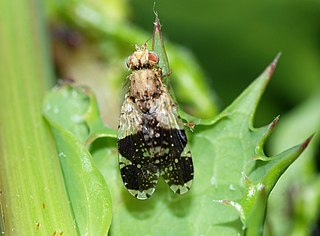Baryplegma is a genus of tephritid or fruit flies in the family Tephritidae.

Procecidochares is a genus of tephritid or fruit flies in the family Tephritidae.
Polionota is a genus of tephritid or fruit flies in the family Tephritidae.

Tephritis is a genus of flies. It contains around 170 described species, making it the sixth largest genus in the family Tephritidae. Many more undescribed species are known from specimen collections. Tephritis occur throughout much of the world, but most are Palearctic. They can be found in a wide range of climate types, from hot semidesert to tundra. Most species inhabit the inflorescences of plants from several tribes in the family Asteraceae, and a few species cause galls to form.

Terellia is a genus of tephritid or fruit flies in the family Tephritidae.

Urophora is a genus of tephritid or fruit flies in the family Tephritidae.

Euaresta is a genus of flies in the family Tephritidae that live in plants of the closely related genera Ambrosia, Xanthium, and Dicoria, and feed on their flowers and seeds.
Tetreuaresta is a genus of tephritid or fruit flies in the family Tephritidae.

Xanthaciura is a genus of tephritid or fruit flies in the family Tephritidae.

Urophora stylata is a species of tephritid or fruit flies in the genus Urophora of the family Tephritidae. The host plant for the larvae is usually a thistle of genus Cirsium or Carduus.

Eurosta is a genus of gall maker flies in the family Tephritidae. There are seven species in the genus, all in North America.
Dictyotrypeta is a genus of the family Tephritidae, better known as fruit flies.
Dyseuaresta is a genus of tephritid or fruit flies in the family Tephritidae.
Eutreta is a genus of the family Tephritidae, better known as fruit flies.

Acrotaeniini is a tribe of tephritid or fruit flies in the family Tephritidae.
Eurosta cribrata is a species of tephritid or fruit flies in the genus Eurosta of the family Tephritidae.
Polymorphomyia basilica is a species of tephritid or fruit flies in the genus Polymorphomyia of the family Tephritidae.
Polymorphomyia striola is a species of tephritid or fruit flies in the genus Polymorphomyia of the family Tephritidae.
Polymorphomyia tridentata is a species of tephritid or fruit flies in the genus Polymorphomyia of the family Tephritidae.








